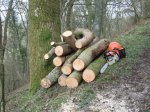Anyone have experience of bio-degradable chainsaw bar oil?
I'm a good way through this year's planned coppicing and thinning (I'll put some details up when I have a moment). My chain oil is now running low and I am considering switching to a bio-degradable type (Stihl BioPlus for example). It seems a bit irresponsible to spend the next 20 years (I hope) spraying petroleum based oils around the wood! I have heard rumour that they solidify and clog up the chain but this may be from people not prepared to pay the 25% increased cost or it may be true.
So, any of you have personal experience? If not, I'll get some and let you know
I'm a good way through this year's planned coppicing and thinning (I'll put some details up when I have a moment). My chain oil is now running low and I am considering switching to a bio-degradable type (Stihl BioPlus for example). It seems a bit irresponsible to spend the next 20 years (I hope) spraying petroleum based oils around the wood! I have heard rumour that they solidify and clog up the chain but this may be from people not prepared to pay the 25% increased cost or it may be true.
So, any of you have personal experience? If not, I'll get some and let you know







